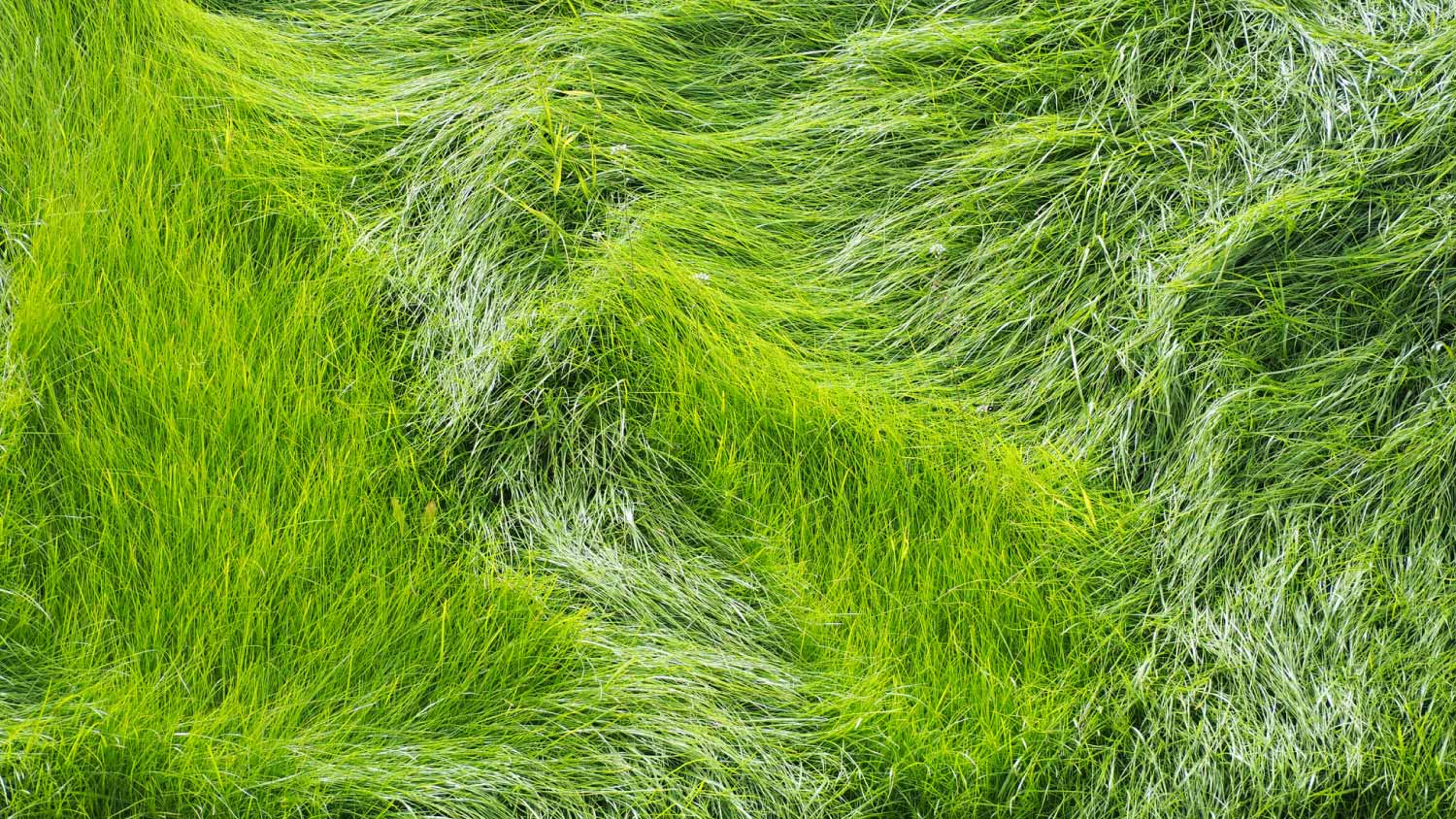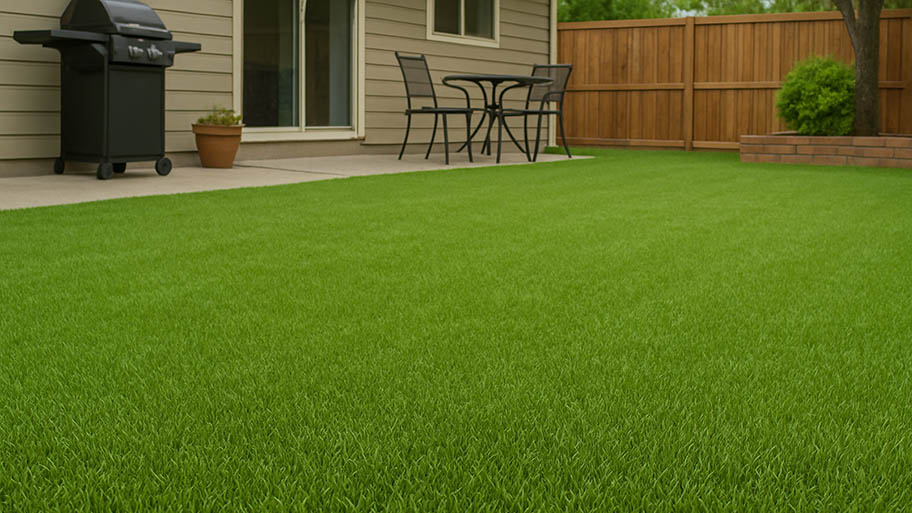
Removing an old lawn is often necessary to plant new grass or build a new outdoor structure. Find out what to budget for your lawn removal cost.
Create a lush looking lawn without the hassle


No-mow grass consists of various types of fescue grass.
No-mow grass requires much less maintenance than traditional grass, including only mowing twice per year.
Consider other grass alternatives, such as artificial grass, wildflower yards, and clover.
A lush lawn is a beautiful sight, but you may not want to consistently mow your grass every week. If that’s the case, you may be weighing the pros and cons of no mow grass.
You may skip mowing here and there, but unless you have specific types of grass, your lawn can overgrow quickly. So, what’s a busy homeowner to do? Don’t worry—you don’t have to resort to paving your lawn.
You can have a gorgeous yard with no mow grass, requiring less maintenance. Let’s dive into no mow grass pros and cons, alternatives to choose from, when to hire a lawn care professional, and if it’s right for your yard.
When taking on this project, expect questions only a pro can answer. With our network of local pros, you'll get the job done and your questions answered—without the hassle and stress of doing it yourself.

No mow grass is a blend of various types of fescue grasses that are fine and hard. These types of grass create a dense yet slow-growing lawn that requires less upkeep, meaning you can mow it on a much less frequent schedule.
Fescues are cool-season grasses, with quite a few different types of them. Here are some common types of fescue grasses used for no-mow lawns:
Creeping Red Fescue: This grass can thrive in humid and cool environments. It is drought-resistant and tolerates shade well. It is dense but has a fine texture and a dark green color.
Sheep Fescue: This grass grows fine blades and is blue-green or gray-green. Its deep and fibrous root system makes it ideal for preventing erosion, and it’s drought-tolerant.
Chewings Fescue: This dense dark green grass is resilient, can thrive in shady areas, and is slow-growing, making it a great choice for a no-mow yard.
Hard Fescue: This grass has a high tolerance to heat and doesn’t require much maintenance. Some types can grow up to six inches tall before needing to be mowed.
Although you will not have to mow nearly as much, how often you mow depends on how manicured of a yard you want. If you prefer a more kept look, then you may need to mow about once per month.
However, the point of a no-mow lawn is to reduce mowing to about twice per year. You will still need to upkeep walkways more frequently, but it’s much less work than a normal mowing schedule.
Now that you know the types of grasses you should use, let’s dig into no-mow grass pros and cons. There are quite a few benefits of having a no-mow lawn, such as:
Longer grass can provide food and shelter to various types of insects and wildlife, such as newts, frogs, lizards, and birds. All of these living creatures benefit from the shelter of the dense grass.
Plus, allowing the grass to grow along with different types of plants, it can also provide a food source for pollinators and wildlife.
Many people are drawn to no-mow lawns because they require much less maintenance. The type of grasses used for the yard are slow-growing, which means you don’t need to cut the grass every week.
In fact, even if you want a shorter manicured yard you can still get away with mowing about once per month. However, as stated before, most no-mow yards are only mowed about twice per year, with some additional maintenance required for pathways.
Another pro of no-mow grass is that it saves water. The fescue grass root systems run deep, enabling it to retain moisture more easily, and it establishes quickly.
This water-saving measure can also be beneficial for areas prone to drought conditions because your yard will stay lush and green without having to stick to a consistent watering schedule.
You should always weigh the pros and cons of no-mow grass. So, let’s discuss a few disadvantages of this type of yard to help you decide if it’s the right choice for you.
The benefit of no-mow grass is that you only have to cut it a few times per year. However, mowing can be much more difficult because this type of grass is long and dense.
When it is time to mow, you must take your time and remove piles of grass clippings. Remember to ensure your mower blades are sharp and ready to take on this task. If the prospect of mowing no-mow grass is too difficult, consider hiring a local lawn care service to tackle it for you.
While it’s wonderful to have a no-mow lawn that benefits wildlife and insects, the downside is it can also attract some unwanted guests, such as snakes and other lawn pests. Dense grass can give slithering snakes an easy place to hide, which can be dangerous for you and pets.
It can also attract various types of pests, such as ticks, which may be a nuisance if you spend a lot of time outdoors in your yard.
Although you will not spend as much time on your mower, you will still need to maintain any walkways, flowerbeds, or edges you want to prevent grass from growing. Fescue grass grows dense and can layover into these areas, so you will need to trim it back.
If you’re not sold on no-mow grass, there are alternatives you can use instead. Here are some gorgeous, low-maintenance alternatives that will make your lawn luscious without the labor:
Artificial Grass: If you’re looking for a lawn that will stay green year-round, consider installing artificial grass. There’s a variety of styles to choose from, and it can last up to 25 years. There are pros and cons of artificial grass to consider, but it can be ideal if it suits your circumstances.
Clover Lawn: Opt for clover as an easy alternative to no-mow grass. White clover is beautiful, attracts bees and pollinators, and grows to heights between 2 inches to 8 inches tall.
Moss: An excellent choice to attain a low-maintenance, whimsical-looking lawn. There are many different types of moss to choose from, and it provides a rich green color and has a soft, springy texture.
Creeping Thyme: Rather than going for the green look, why not have gorgeous blooms flowering throughout your yard instead? Creeping thyme is a flowering plant that grows about 2 inches to 3 inches tall and produces beautiful flowers for a lovely-looking lawn while providing a source of food for pollinators.
Wildflower Yard: If you fancy the thought of a lawn full of exquisite wildflowers, this is the perfect option for a no-mow yard. Wildflowers would make an excellent eco-friendly lawn that would benefit wildlife without worrying about mowing the grass.
Deciding if no-mow grass is right for you depends on a few factors. For instance, if you are trying to replace an existing yard, it’s going to require some work and cost to remove the existing grass and prepare the soil for the new seed. You will also need to decide if you want no-mow grass or one of the alternatives, such as clover, wildflowers, or artificial grass.
If you want a lush-looking lawn without the hassle, artificial grass may be the way to go. However, it can be costly. The average price range to install an artificial grass lawn is between $3,040 and $7,960. However, you will save money on your water bills, will not have to worry about mowing anymore, and will have green grass all year long for up to 25 years. If that sounds appealing to you, then hire an artificial grass company near you to install your lawn.
From average costs to expert advice, get all the answers you need to get your job done.

Removing an old lawn is often necessary to plant new grass or build a new outdoor structure. Find out what to budget for your lawn removal cost.

The cost to renovate your lawn depends on the extent of the damage. Our guide will show you how much lawn renovation costs.

Artificial grass is a low-maintenance alternative to traditional turf. Learn how much artificial grass installation costs and what affects your price.

Of all the increasingly popular grass alternatives, clover is edging out the competition. Get to know the top clover lawn pros and cons and whether this option is right for you.

What is Bermuda grass? This resilient grass can take your lawn from drab to fab. Consider our planting and caretaking tips to ensure your emerald sod thrives.

Learn how to remove yard waste properly and efficiently with these methods.